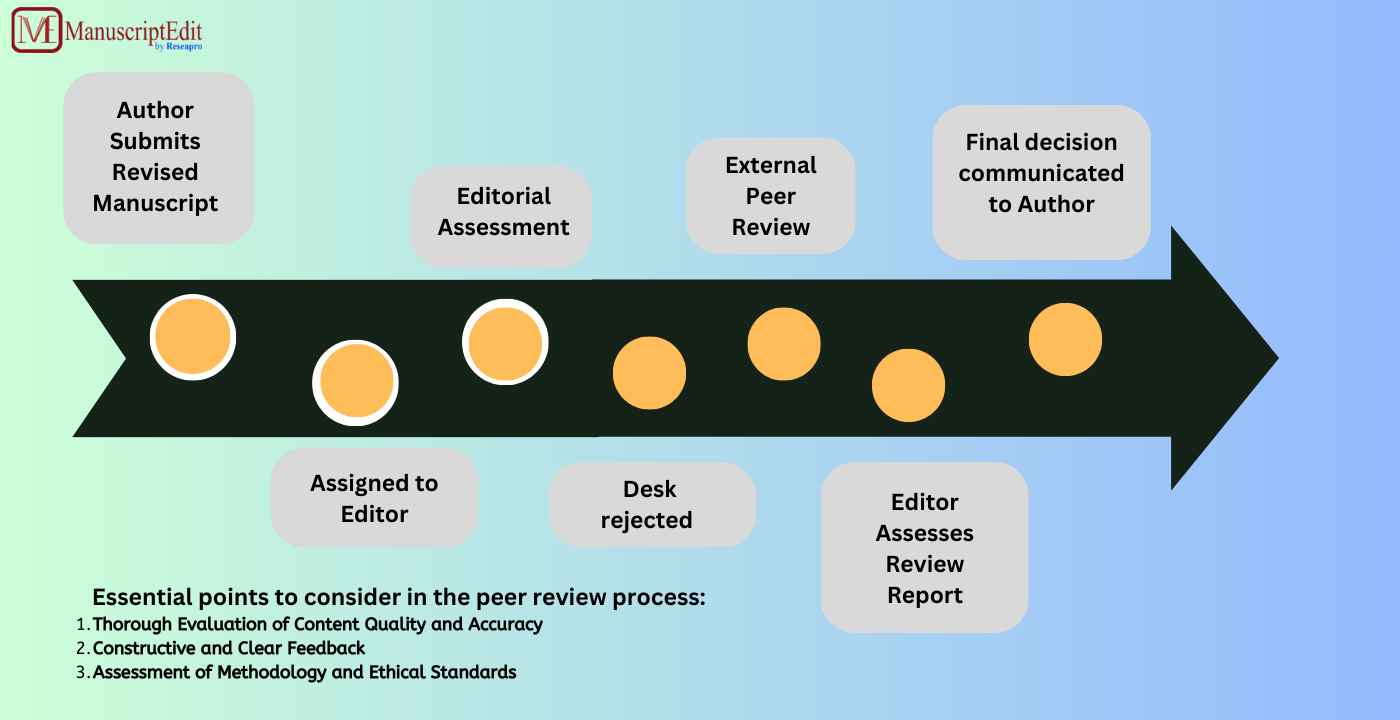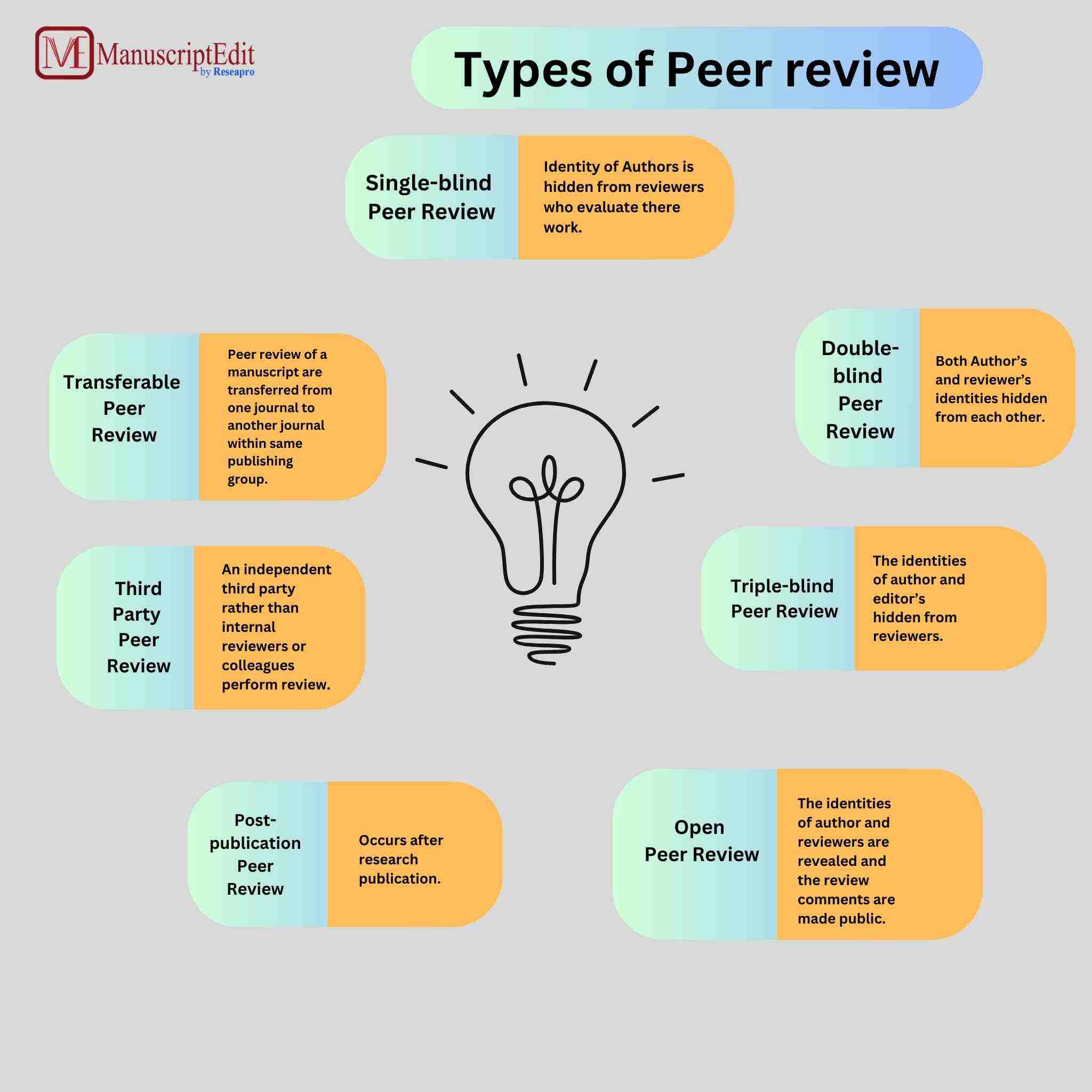|
Getting your Trinity Audio player ready...
|
 What Is The Peer-Review Of A Manuscript?
What Is The Peer-Review Of A Manuscript?
- Peer-Review is a process in which the Manuscript proposed for the Publication of the Journal is assessed by a group of experts in the appropriate field.
- It can be said as a sign of recognition in one’s field.
Who is involved in the Process of Peer-Review?
- Experts in the appropriate field.
- Editorial Board Members.
Evaluation Stages
Initial Evaluation
- Read the Abstract & Conclusion.
- Skip the Figures, Data, Tables.
In-Depth Evaluation
- Read the entire script
- Note the details
- Getting Answer to these Questions
- Is the quality of the manuscript good for a conclusion?
- Is the experimental design appropriate?
- Is there any non-relevant data?
How does Peer-Review Work?
- The Research Scholars writes a Paper & Submits the Manuscript to the Academic Journal that publishes similar or related types of works.
- The Journal Editor reads the Manuscript and decides whether it meets the criteria for Publication or not. If it is rejected, the manuscript goes back to the Researcher with a polite rejection letter. If it meets the criteria, then the Manuscript is accepted and is sent to the scientific community who will read it as well.
- The reviewers read the manuscript to evaluate in terms of its purpose, scope, thesis, outcome and ask questions such as
- Is the topic worth investigating?
- Are relevant sources being used?
- Does the evidence support the thesis?
- Is the thesis clearly and convincingly argued?
- Is the work original?
- Once the reviewers have finished reading the manuscript, they send their comments to the editor, who in turn, sends it to the writer another letter that will either accept the paper without revisions or will provide comments and ask for revisions based on the peer reviewers’ evaluation of the work.
- Once the paper is revised to the satisfaction of the editor and the reviewers take several revisions, the article is published.
- When using Peer-reviewed articles for research papers and assignments, can use the best data or information available upon which to base your work.
Peer Review Methodology

What Are the Questions to Focus on While Peer-Reviewing a Manuscript?
Peer review is a cornerstone of the academic publication process. It involves experts in the field critically evaluating a manuscript to ensure the quality, validity, and significance of the research. As a peer reviewer, your responsibility is not just to assess the scientific content but to provide constructive feedback that helps authors improve their work. To conduct an effective peer review, it’s crucial to ask the right questions at each stage of the manuscript. In this article, we will explore the key questions to focus on when reviewing a manuscript to ensure it meets high academic standards.
Title: Is It Aligned with the Manuscript?
The title of a manuscript is the first impression a reader gets, so it’s vital that it reflects the research accurately and concisely. When reviewing the title, ask yourself the following questions:
- Is the title an accurate reflection of the manuscript’s content? The title should clearly describe the research and its focus. Avoid titles that are misleading or too vague, as they can confuse readers about the content.
- Are the major findings mentioned in the title? While not all titles need to include every detail, it should ideally give an idea of the central findings or results of the research.
- Is the conclusion overstated in the title? Ensure the title does not overstate the manuscript’s conclusions. It should remain factual and representative of the study’s outcomes.
Abstract: Does It Stand Alone?
The abstract serves as a brief overview of the entire manuscript. A good abstract allows readers to quickly assess whether the paper is worth reading. Ask the following questions:
- Can the abstract stand alone? The abstract should summarize the main points of the research—background, methods, results, and conclusion—in a concise way. It should be understandable without needing to read the entire paper.
Introduction: Is It Clear and Focused?
The introduction of a manuscript sets the stage for the research by providing background and outlining the study’s objectives. When reviewing the introduction, consider these questions:
- Is the introduction brief and to the point? The introduction should not be too detailed but should focus on introducing the research problem and providing enough context for the reader to understand the study’s purpose.
- Does the introduction clearly state the aim or objective of the research? A well-defined research question or objective is crucial for the reader to understand the study’s scope and relevance. Make sure the aim is stated clearly.
Methods: Are They Appropriate?
The methods section outlines the procedures and techniques used to conduct the research. This section is critical in evaluating the reliability and validity of the study. Key questions to ask include:
- Are the methods appropriate for the research question? Ensure that the chosen methods are suitable for answering the research question. If the methods seem inadequate or unclear, they need to be flagged.
- Is the statistical analysis clearly provided? For quantitative research, check if the statistical analysis is described clearly and appropriately. Inadequate or confusing analysis can undermine the credibility of the results.
Results: Are They Clearly Presented?
The results section reports the findings of the study. The clarity of this section is essential for readers to interpret the research outcomes correctly. Consider these questions:
- Is the paper within the scope of the research question? Verify that the results align with the research question posed in the introduction. If the results stray too far from the research question, this should be pointed out.
- Does the paper address an important and interesting research question? As a reviewer, assess whether the research question is of significance and whether the results contribute valuable insights to the field.
- Is the manuscript readable? Clarity is key in presenting research results. Check if the manuscript is well-structured and easy to follow, with clear headings, figures, and tables.
Overview of Peer-Review: Confidentiality and Constructive Feedback
Peer reviewing is not just about evaluating the scientific content but also about providing feedback that helps the author improve. Keep these points in mind:
- Confidentiality: The manuscript should be kept confidential. You must not share its content or discuss it with others without explicit permission.
- Constructive Feedback: Feedback should be specific, constructive, and respectful. It should highlight areas for improvement, along with the reasons for the suggestions. A peer review should aim to enhance the manuscript and help the author improve their work.
How Is Peer-Review Beneficial in Academic Writing?
Peer review is not just valuable for the manuscript under review—it also provides significant benefits to the academic community and the reviewer. Here’s how peer review helps in academic writing:
- Improves Writing and Critical Thinking Skills: As a peer reviewer, you engage critically with research, improving your own analysis, writing, and evaluation skills.
- Develops Collaborative Learning: Peer reviewing promotes collaborative learning. You can exchange ideas with authors and other reviewers, which fosters a rich academic discussion.
- Encourages the Writer to Perform Better: Constructive feedback motivates authors to refine their work, enhancing their academic writing and research.
- Saves Time for Researchers: Reviewing other manuscripts allows you to stay up-to-date with the latest research in your field, saving time when conducting your own work.
- Ensures Quality Research is Published: The peer review process ensures that only high-quality, rigorously evaluated research is published, contributing to the credibility of scientific literature.
Peer-Reviewer’s Focus on Manuscript Readability
The readability of the manuscript is crucial for ensuring effective communication. Pay attention to the following:
- Is the manuscript easy to read? Check if the manuscript is written clearly and logically. The writing should be accessible and easy to follow, avoiding complex jargon.
- Are the sentences easy to read? Sentences should be well-structured and concise. Avoid long, convoluted sentences that may confuse the reader.
- Are the sentences grammatically correct? While minor grammar errors may slip through, major issues can distract from the manuscript’s overall quality. Look out for typos, sentence structure issues, and punctuation errors.
Conclusion: The Importance of a Good Peer Review
A good peer review is vital in maintaining the quality of academic research. A well-executed review should be focused, constructive, and structured. Here’s a summary of the key attributes of a high-quality peer review:
- Focused: The review should concentrate on the key areas of the manuscript.
- Constructive: Identify issues and provide suggestions for improvement.
- Structured: Follow a systematic approach to ensure the review is organized.
- Polite and Professional: Communicate feedback in a respectful and professional manner.
- Listing Strengths and Weaknesses: Highlight both the manuscript’s strengths and weaknesses.
- Recommendations for Changes: Provide specific, actionable suggestions to improve the manuscript.
By following these guidelines, peer reviewers contribute significantly to the academic community, ensuring that high-quality, credible research is shared with the world.
FAQs
- What is the role of a peer reviewer? A peer reviewer evaluates a manuscript’s scientific quality, relevance, and clarity, offering constructive feedback to improve the research.
- Why is the title important in peer review? The title is the first impression of the research. It should accurately reflect the content and key findings of the study.
- What should a peer reviewer look for in the abstract? The abstract should provide a concise summary of the research, including the background, methods, results, and conclusion.
- How can peer review improve academic writing? Peer review helps writers refine their research, improve their writing, and receive valuable feedback to enhance their manuscript.
- What is the significance of the peer review process? Peer review ensures that only high-quality, reliable research is published, maintaining the integrity of scientific literature.



